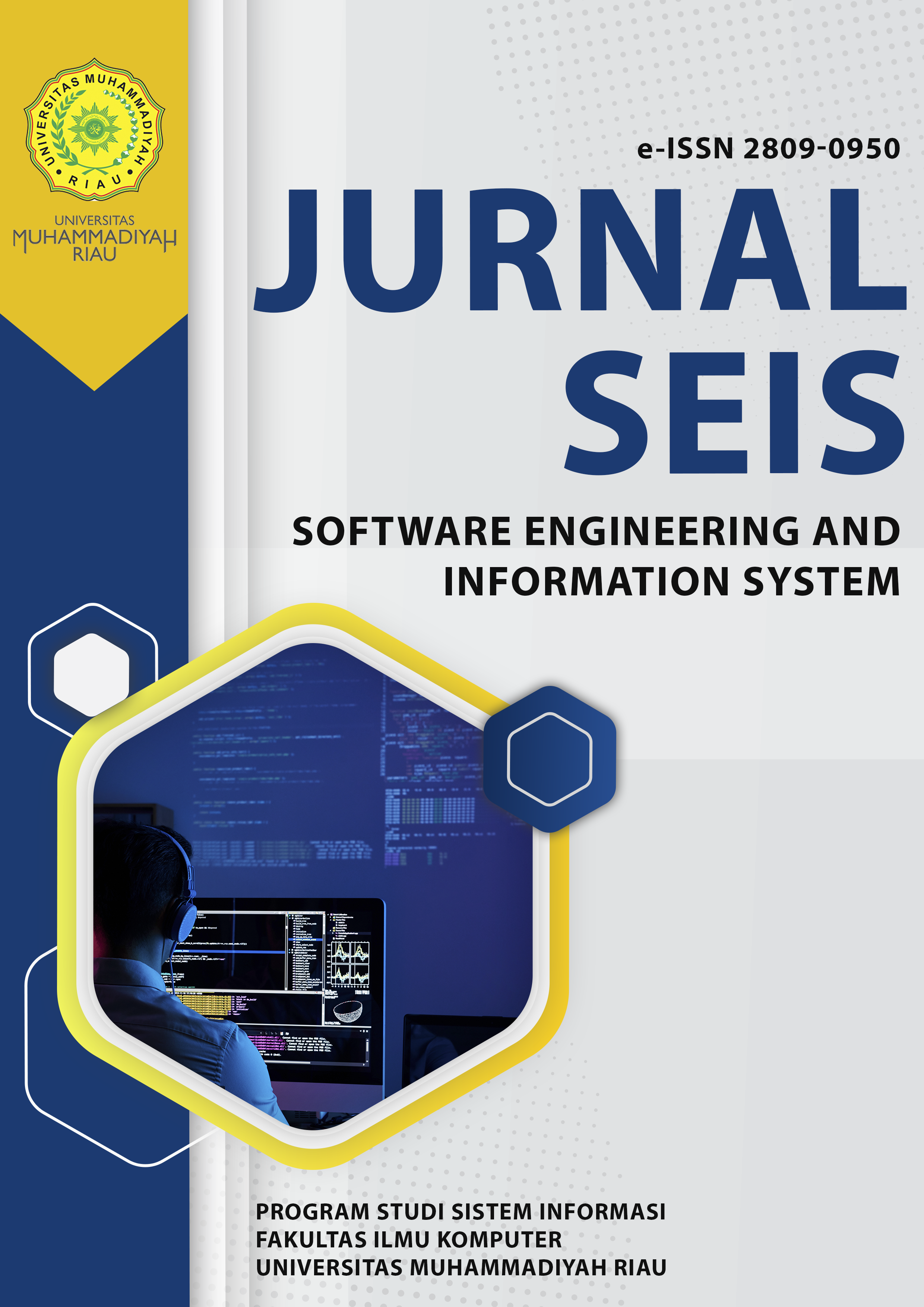STRATEGI PENERAPAN WIRELESS MESH NETWORK UNTUK PENGINGKATAN DAN KEANDALAN JARINGAN NIRKABEL
DOI:
 https://doi.org/10.37859/seis.v5i2.9604
https://doi.org/10.37859/seis.v5i2.9604
Abstract
The need for reliable communication networks that cover a wide area is becoming increasingly important, especially in areas with limited conventional network infrastructure. One promising solution to overcome this challenge is the implementation of Wireless Mesh Network (WMN), which offers flexibility, scalability, and redundancy through direct connectivity between nodes. This study aims to design and evaluate a Wireless Mesh Network (WMN) implementation strategy to improve the reliability and performance of wireless networks. The methods used include mesh topology analysis, adaptive routing protocol selection, and network performance simulation using throughput, delay, and packet delivery ratio parameters. The preliminary results show that the implementation of Wireless Mesh Network (WMN) with proactive routing protocols such as Optimized Link State Routing (OLSR) and a hybrid approach provides an increase in throughput of up to 35% and reduces the average delay by 20% compared to traditional infrastructure-based networks. In addition, network reliability is increased through self-healing capabilities, namely the ability of the network to reset the communication path when there is a disruption to one of the nodes. These findings indicate that the right Wireless Mesh Network (WMN) implementation strategy can significantly improve the efficiency and reliability of wireless networks, especially in environments with physical or geographical limitations. This study recommends the use of adaptive mesh topology to support continuous connectivity and more resilient network management.
Downloads
References
Afian Musthofa, M., Hari Trisnawan, P., & Primananda, R. (2019). Perancangan Jaringan VoIP Berbasis SIP pada Wireless Mesh Network (WMN) menggunakan Routing Protocol OLSR (Vol. 3, Issue 9). http://j-ptiik.ub.ac.id
Agussalim, A., Kartika, D. S. Y., & Rahajoe, A. D. (2023). Implementasi Ad-Hoc Protocol Pada Tandem Multihop Wireless Network. Jurnal Sistem Dan Teknologi Informasi (JustIN), 11(2), 377. https://doi.org/10.26418/justin.v11i2.58051
Ainurrachman, S., Bhawiyuga, A., Hannats, M., & Ichsan, H. (2017). Analisis Perbandingan Performansi Protokol Routing OLSR dan SOLSR Pada Wireless Mesh Network. 1(10), 1182–1192. http://j-ptiik.ub.ac.id
Chaugule, M., & Desai, A. (2016). Reliable Metrics for Wireless Mesh Network. International Research Journal of Engineering and Technology. www.irjet.net
Fattah P Ripto, M. N., Hari Trisnawan, P., & Primananda, R. (2021). Implementasi Wireless Mesh Network berbasis Protokol Routing BATMAN untuk Video Live Streaming dengan menggunakan Fitur Network Coding (Vol. 5, Issue 11). http://j-ptiik.ub.ac.id
Intervlan, I., & Hsrp, D. A. N. (2024). Optimalisasi Jaringan Komputer Di Smk Travina Prima Dengan. 8(4), 438–447.
Ismail, N., Faroqi, A., Kamelia, L., Mardiati, R., Elektro, J. T., Sains, F., Teknologi, D., Islam, U., Sunan, N., & Bandung, G. D. (2011). Simulasi Wireless Mesh Network (Wmn) Untuk Mendukung Implementasi Next Generation Network (Ngn). Jurnal Elektro, 5(1–2), 204–214. http://download.portalgaruda.org/article.php?article=345894&val=8064&title=Simulasi Wireless Mesh Network (Wmn) Untuk Mendukung Implementasi Next Generation Network (Ngn)
Manullang, F. M., Cahyani, N. D. W., & Suryani, V. (2012). Analisis Performansi Routing Hybrid Wireless Mesh Protocol (HWMP) pada Wireless Mesh Network (WMN) Berdasarkan Standar IEEE 802.11S. Jurnal SIFO Mikroskil, 13(1), 43–52. https://doi.org/10.55601/jsm.v13i1.45
Nurmawan, H., Soedijono, B., & Pramono, E. (2020). Perancangan Perbandingan Jumlah Hop Pada Wireless Mesh Network. Jurnal Informa : Jurnal Penelitian Dan Pengabdian Masyarakat, 5(4), 67–72. https://doi.org/10.46808/informa.v5i4.158
Raafi’ilman, A., Bhawiyuga, A., & Siregar, R. A. (2019). Implementasi Protokol RF24Mesh dalam Wireless Sensor Network pada Lahan Pertanian. Jurnal Pengembangan Teknologi Informasi Dan Ilmu Komputer, 3(7), 6757–6763. http://j-ptiik.ub.ac.id
Rantelinggi, P. H., & Djanali, S. (2015). Kinerja Protokol Routing Pada Lingkungan Wireless Mesh Network Dengan Combined Scalable Video Coding. JUTI: Jurnal Ilmiah Teknologi Informasi, 13(1), 86. https://doi.org/10.12962/j24068535.v13i1.a391
Siswanto, D. (2021). Implementasi Wireless Mesh Network Pada Jaringan Local Area Network (Lan). Journal of Science and Social Research, 4307(1), 20–27. http://jurnal.goretanpena.com/index.php/JSSR
Suryadin, I. T., Winarno, W. W., & ... (2017). Rancang Bangun Freifunk Pada Wireless Mesh Network DENGAN STANDAR IEEE 802.11 b/G. Jurnal Ekonomi Dan …, 5, 38–56. http://e-journal.polsa.ac.id/index.php/jneti/article/view/33%0Ahttps://e-journal.polsa.ac.id/index.php/jneti/article/download/33/26
Utama, A., & Setia Budi, A. (2024). Sistem Pendeteksian Node Baru Otomatis pada WSN Topologi Mesh berbasis ESP-NOW. Jurnal Pengembangan Teknologi Informasi Dan Ilmu Komputer, 8(1), 51–57. http://j-ptiik.ub.ac.id
Wilantika, C. F. (n.d.). Penerapan Mesh Wi-Fi System untuk Akses Internet di Desa Terpencil Kabupaten Lebak.
Yang, K., & Ma, J. F. (2009). Hybrid wireless mesh protocol. Tongxin Xuebao/Journal on Communications, 30(11 A), 133–139.
Downloads
Published
Versions
- 2025-10-15 (2)
- 2025-08-21 (1)
How to Cite
Issue
Section
License
Copyright (c) 2025 Tiara Sela Juniarti Juniarti, Fitriah

This work is licensed under a Creative Commons Attribution-ShareAlike 4.0 International License.
Copyright Notice
An author who publishes in the Journal of Software Engineering and Information System (SEIS) agrees to the following terms:
- Author retains the copyright and grants the journal the right of first publication of the work simultaneously licensed under the Creative Commons Attribution-ShareAlike 4.0 License that allows others to share the work with an acknowledgement of the work's authorship and initial publication in this journal
- Author is able to enter into separate, additional contractual arrangements for the non-exclusive distribution of the journal's published version of the work (e.g., post it to an institutional repository or publish it in a book) with the acknowledgement of its initial publication in this journal.
- Author is permitted and encouraged to post his/her work online (e.g., in institutional repositories or on their website) prior to and during the submission process, as it can lead to productive exchanges, as well as earlier and greater citation of the published work (See The Effect of Open Access).
Read more about the Creative Commons Attribution-ShareAlike 4.0 Licence here: https://creativecommons.org/licenses/by-sa/4.0/.










